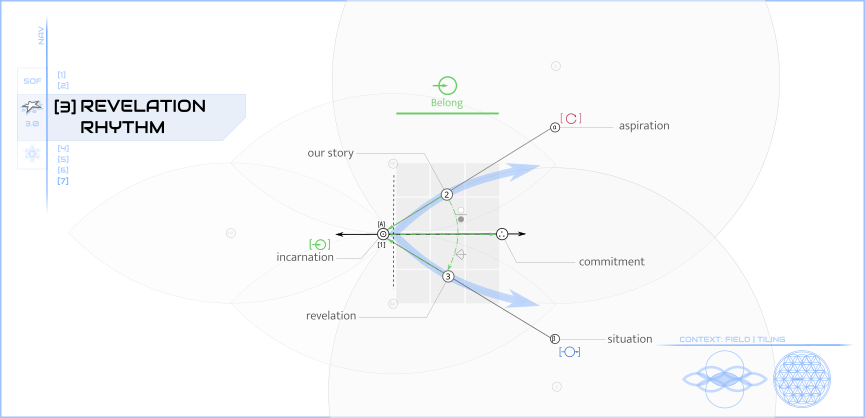[3] Revelation Rhythm
Revelation Rhythm describes a zone on The Journey Map of personal and communal spiritual journey. As [2] The Story Zone creates space for story telling and sharing experiences, the lives of the co-journeyers are eventually woven together into the context of Our Story. This is the space or “seed bed” for new meaning to be discovered in encounters and experiences. This meaning can take many forms of synthesis: aiming, next steps, experiments, virtues, value, and myth making (creating our own symbols and symbolic stories). As revelation reveals meaning, the participants come to belong to each other, not on the level or shared experience, but on the level of shared mission. They start to say, “I/we need to embody/incarnate this; I/we need to commit to this.” This incarnational identity and commitment propels them to the transition into the Become phase.
Elements
Aspiration (α)
What I/we want
What I/we want to be
Situation (β)
What demands must be met
What stands in the way
2. Our Story
What we are experiencing
Our story is the broadening of individual stories heard and received in [2] The Story Zone into a sense of shared story for those journeying together. As people tell their stories and create new chapters together, their lives are woven into each other creating a shared context1 This is a ready space for new discoveries and experiments to take place: the seed bed for revelation.
3. Revelation
What this means for us and others
Revelation is localization where purpose and identity (incarnation/Prime) intersect with the situation (Beta) to form mission. It happens when participants encounter changes in scope in their experiences. This creates meaning for the members and community on the journey together in the form of virtue and value. Virtue is meaning held internally in the identity/character of individuals and groups (as in “our values” or “core values”). Value is meaning held externally in tangible benefits and experiences (as in “product”, “offering”, or “producing value”).
Incarnation ([1], ⊙)
Why me/us
Revelation reveals original identity: the sense of self as destined to embody a particular meaning and mission. In other words, original identity is the sense of “this is who I was always meant to be.” In that sense, this product of revelation is always incarnational, meaning it manifests something spiritual through embodiment.
Commitment (∴)
Why its worth it
Why it matters
Incarnational identity is “tuned” to particular ways of becoming based on the aiming balance produced between the tension of Our Story and Revelation. This means the sense of who I/we are meant to be is correctly and fully committed to all the necessary changes and applications of identity to see the mission through.
Dynamics
The space opened up by the interplay and creative tension of aspiration (Alpha) and situation (Beta) in [2] The Story Zone, now gets populated with the seeds of change on different levels of scope. Notice that the elements of [3] Revelation Rhythm, especially (2) Our Story, and (3) Revelation, scale down the “bigger-than-system” energy of aspiration and situation to a scope that can be experienced and experimented with on human-scales consistent with individual and communal readiness. This is the meaning of the “funnel” shape of this zone. In takes the big elements of story and filters them down so they can be used to produce the products of revelation: virtue, value, and symbolic story.
In the Story Zone, both aspiration and situation should be received uncritically. You can dreams as big and you want, and you can feel however you want about your situation, whatever the reality may be. But now in this zone, it becomes necessary to localized these. Our Story localized aspiration to: what part of our aggregate aspirations can we begin to live out now? Revelation localizes situation to: what virtue and value can we create for those in our situation? The interplay of these localizations causes people on the journey to begin to incarnate the synthesis of these two: the mission. As the community finds rhythms of revelation, this incarnation will increase until the participants are ready to commit fully to the identity changes and application the mission and the community will require.
Generally, people’s progression in this zone will be according to [3] David’s Bow — following the pattern of orientation, disorientation, and re-orientation. Orientation will happen as revelation occurs during the change of scope from aspiration to Our Story. Disorientation will happens as change of scope between situation and Revelation occur. And finally, re-orientation around incarnation will occur as these two begin to synthesize new identity for participants. This is important because most people cannot start with incarnation: they don’t yet know what the identity they want to become looks like, so they need to work of revelation to describe it.
How to Help
If you’d like to help people who are in the Revelation Rhythm zone of their journey, your main objective must be for people to discover meaning (revelation) and see how such meaning connects them with others. This is not the same as telling or giving people the meaning, which will often disrupt the power and ownership that comes through legitimate discovery. It’s better to design environments and interactions so we are co-journeyers with people as they make discoveries.
There are two basic channels of revelation: meaning making and mythos making. Meaning making is the physical world / external channel where we use our virtue to make something of value for someone else. The more remarkably we translate virtue into value, the more revelatory the experience of providing and receiving that value will be. Mythos making is a more the conceptual world / internal channel where we create symbols to culturally encode the experience of value (embedded with virtue) and translate this into new stories. New stories, as they are told, strengthen existing virtues and suggest new ones which, in turn, refine and increase value so that the cycle continues. In other words, revelation comes from the context of both creating value for people out of who we are and from the symbolic stories we share about our journey.

Revelation is more than new information: it’s also the energy that comes from discovery. This means that revelation most often happens when there is a change of scope in the meaning making or mythos making channels (or between the two). For example, a person my have a revelation when they encounter a large societal problem in the life of a close friend that is otherwise hard to comprehend, but the change in scope brings a sudden, astonishing realization. The change in scope leads to the “Ah-ha”, so to speak. In the same way, a person may feel their own experience or contribution is inconsequential until they suddenly come to realize how many people can relate to them or benefit from the value they create. Again, the revelatory power is enhanced by the change in scope.
A change of scope can be nearly any major shift in perspective, but there are some particularly helpful places where changes of scope lead to revelation. Among the most powerful is a shift in scope based on The Three Levels of agency or identity:

People have three distinct self-concepts: the personal self, the relational self, and the collective self. We use the term “systemic” instead of collective because, while this includes group contexts, it also includes institutions and meta-level phenomenon like trends. Often a change of scope from one of these self-concepts to another will lead to revelation. Because Mythos (symbolic story) plays a central role in mediating between the personal and the collective/systemic, it is often the channel through which this scope of revelation is best activated.2 In addition to giving access to change of scope related to self-concept, Mythos — since it is story-based — has the advantage also of accessing small-big scopes, past-future scopes, and familiar-strange/novel scopes.
For our purposes here, we’ll define Mythos as the fundamental human power underlying all culture through symbolic story. A myth is — according to our usage — not a fictious story, but rather any story that contains culturally powerful symbols. In this way, even non-fiction like history and science can function as myth in a culture as the stories of things that really happened take on symbolic meaning. For example: think how historical events can take on powerful political meaning (think “Pearl Harbor”).
Sources of Mythos
When helping people encounter revelation at any social scale (one-on-one, small group, large group), careful attention should be given to creating rhythms that change scope in conversation and real-life value-creating experiences and booked ending these conversations and experiences with mythos-making through sharing relevant, contextualized myth.


